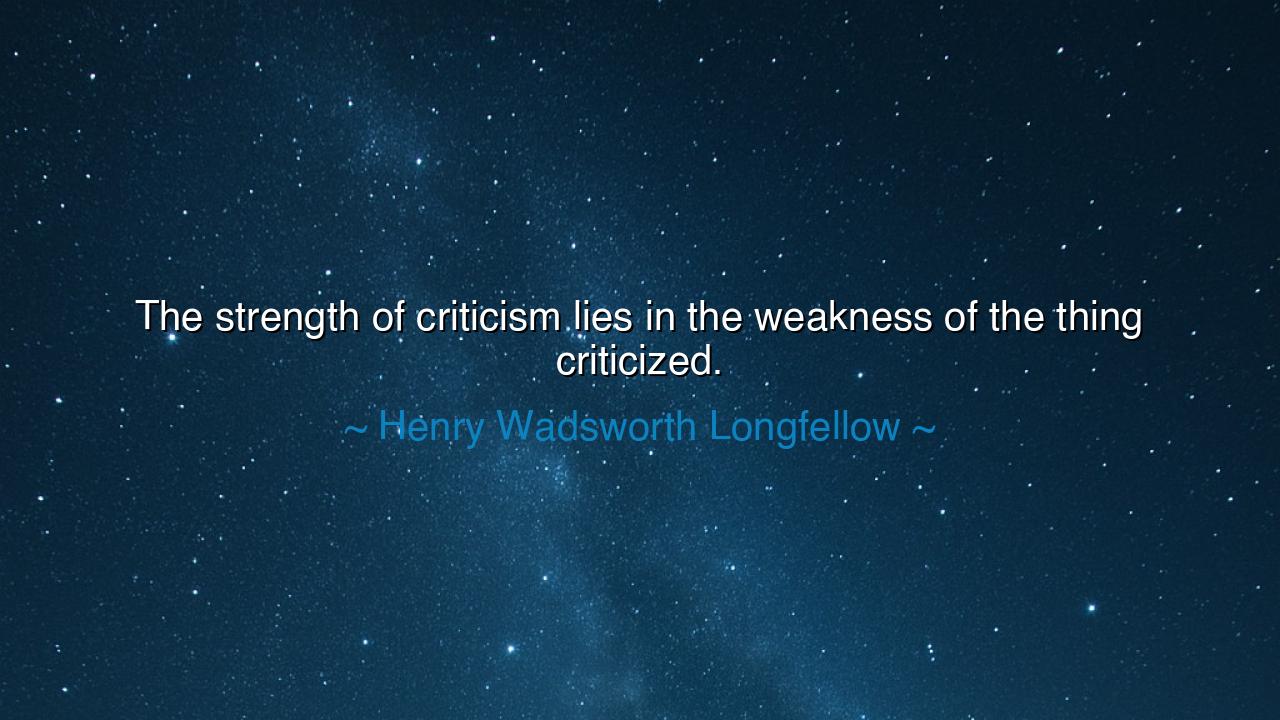
The strength of criticism lies in the weakness of the thing






Hear the words of Henry Wadsworth Longfellow, poet of America, who once declared: “The strength of criticism lies in the weakness of the thing criticized.” These words fall like a hammer upon the vanity of men, reminding us that no attack, however sharp, can wound what is whole, what is true, what is strong. A castle well-built laughs at the arrows that strike its walls, but one with cracks will crumble at the smallest blow. Thus, Longfellow teaches that the power of criticism is never its own, but borrowed from the frailty of what it strikes.
The origin of this saying flows from Longfellow’s own life as a writer, often subject to the judgments of his age. He, who wrote with tenderness and clarity, knew the weight of words both noble and cruel. Yet he perceived that criticism, no matter how loud, could not truly harm what was solid in foundation. Only where weakness existed could criticism find a foothold. A weak argument, a shallow belief, a flawed work of art—these are undone by criticism because their own fragility invites collapse. A truth unshaken, however, remains untouchable, even when surrounded by a chorus of scorn.
History bears witness to this eternal law. Consider the trial of Socrates, condemned by his fellow Athenians. His enemies hurled accusations of corrupting the youth and dishonoring the gods. Yet their criticism found its force not in his strength, but in the weakness of Athens itself. Socrates’ questions had exposed the cracks in the city’s wisdom, the emptiness of its pretenses. The criticism that silenced him was but the reflection of their own frailty, not of his. His ideas endured because they were strong; Athens condemned him because it was weak.
So too, in the story of the Catholic Church and Galileo, we see this truth. The Church’s criticism of his discoveries—condemning him for proclaiming that the earth moved around the sun—rested not on strength but on its own fear of fragility. Its authority was vulnerable, and so it lashed out. Galileo’s science, though suppressed, was not destroyed, for it rested on the firm ground of reality. Thus, the strength of criticism arose not from truth, but from the weakness of a threatened belief.
At the heart of Longfellow’s words is a call to introspection. If you find yourself wounded by criticism, ask not first whether the critic was cruel, but whether there is weakness within yourself that gave their words power. A lie cannot stand against inquiry; a shallow work of art cannot endure sharp eyes; a hollow life crumbles under scrutiny. But the strong heart, the honest mind, the solid deed—they may be shouted against, but they remain unbroken. Criticism, like the wind, reveals where the branches are dry and brittle.
There is also here a warning for those who wield criticism. Do not mistake the collapse of the weak for the triumph of your words. The strength of your attack is only the reflection of another’s frailty. To strike what is whole is futile, to strike what is cracked requires no glory. Therefore, use criticism as a tool not of vanity but of truth—seek to expose weakness that it may be healed, not merely to glory in its ruin.
The lesson is plain: do not fear criticism, but use it as a mirror. When words pierce you, search within for weakness, and strengthen it. When words fall harmless, rejoice, for you are sound. And when you yourself must speak as critic, do so with the spirit of the builder, not the destroyer—revealing weakness so that strength may be born.
Thus, O seeker, remember Longfellow’s wisdom: criticism has no power of its own—it borrows its strength from the weakness of what it touches. Therefore, make your works, your words, and your life strong, so that no judgment can shake them. Build upon stone, not sand. Seek truth, not vanity. And in doing so, you will stand firm as mountains stand against the storm, while lesser things are swept away by even the gentlest breeze.






AAdministratorAdministrator
Welcome, honored guests. Please leave a comment, we will respond soon